What is meant by active listening?
Active listening involves paying close attention to other person's words, tone, body language, and responding thoughtfully. It involves more than just hearing; it requires understanding, reflecting, and showing empathy to them.
Research shows that words, body language, and tone of voice account for 7%, 55%, and 38% of effective communication, respectively.
When we only pay attention to someone's words and ignore their true intent—what do they mean, what are they trying to express, what hasn't been said—we miss out on a large part of communication that ultimately turns into a source of confusion, misalignment of expectations and misunderstandings.
Active listening involves picking up the subtle signals that you would otherwise miss. It involves reading between the lines and paying attention to the way something is said or the context in which those words are spoken.
Why is active listening important?
How do you feel when you're not being heard—frustrated, annoyed and angry at the other person? Do you feel like they don't really know you or they don't really get who you are? This is exactly how others feel when you don't listen.
Listening poorly limits your understanding of others which deprives you from bonding, building trust, learning, growing and most important of all, evolving as a human being. There's a cost to not listening—stress in the workplace, poor relationships, misunderstandings, errors, missed opportunities, arguments, stalled projects, avoidable conflicts, and wasted time.
How you listen and respond to others has a significant impact on the quality of your relationships—be it workplace, family or friends. Research shows that high quality listening leads to superior job performance, better leadership, trust, intimacy, well-being, and reduced burnout.
Listening well benefits everyone:
-
Builds trust and connection by showing interest in others and what they have to say.
-
Leave others more satisfied and fulfilled as they feel respected, understood and appreciated.
-
When others feel heard, they are more likely to reciprocate and listen to you as well.
-
Promotes empathy and emotional intelligence by connecting with others at a deeper level.
-
Enhances memory and retention by being engaged and immersed in the conversation.
-
Minimizes misunderstandings and conflicts by ensuring everyone feels heard and understood.
-
Saves time and energy by uncovering misunderstandings, realigning on goals and catching mistakes early.
-
Encourages continuous learning and development by exposing you to new ideas and perspectives.
What are the 5 levels of effective listening?
When listening to others, we progress through different levels from minimal engagement to deep, empathetic understanding. These five levels of listening reflect varying degrees of engagement and depth in the listening process.
Level 1: Ignoring
Not paying attention to the person or their message. Ignoring them and not really listening to them at all.
Response:
Complete lack of engagement or recognition of their presence.
Examples:
-
A friend is sharing details about a difficult situation at work. You’re engrossed in your phone and don’t make any effort to acknowledge your friend’s words. You don't respond or even look up from your phone.
-
During a meeting, you keep working on your laptop and don't pay attention to your colleague's new idea. As a result, you miss the entire discussion and the opportunity to contribute.
Level 2: Pretending
Giving the appearance of listening but not being genuinely engaged.
Response:
Responding with automatic or noncommittal phrases like "Yeah. Uh-huh. Right," while your mind is elsewhere.
Examples:
-
A colleague is giving you a briefing on a new project. You nod occasionally and say “I see” or “That’s interesting,” but you’re not fully engaged and are mentally preoccupied with your own tasks.
-
While your partner was talking about their day, you kept responding with “Yeah” and “Uh-huh,” but your mind was on a TV show you wanted to watch. You missed the details of their story.
Level 3: Selective
Hearing only parts of the message that interest you or fit with your pre-existing beliefs.
Response:
Filtering information based on personal preferences or biases, leading to incomplete understanding.
Examples:
-
A team member is discussing their feedback on a recent project. You focus only on the parts where they mention issues related to their own work, ignoring their feedback about other team members or the overall project.
-
In a performance review, you pay close attention only when your boss praises your work, but tune out when they discuss areas where you could improve. You focus on the positive feedback and avoid processing the constructive criticism.
Level 4: Attentive
Paying attention, focusing fully on the person and making an effort to understand the words that are being said.
Response:
Giving them your full attention, providing appropriate feedback, and asking questions to clarify.
Examples:
-
A family member is explaining their plans for a family event. You listen with curiosity and ask clarifying questions to ensure you understand their plans and how you can contribute.
-
During a team discussion about a project, you listen carefully to each team member’s input, ask questions to clarify their points, and take notes to ensure you understand their perspective and concerns.
Level 5: Empathic
Deeply understanding and connecting with the person's emotions and perspectives.
Response:
Demonstrating genuine empathy and compassion, recognizing their feelings, and validating their experiences. Getting inside their frame of reference. Seeing the world as they see it, understanding their paradigm, and how they feel.
Example:
-
A friend is talking about a personal challenge they’re facing. You listen deeply, acknowledge their feelings, and respond with empathy. You say things like, “I can see how that would be really tough for you,” and offer support based on their emotional state.
-
Your partner is feeling down about a personal setback. You listen deeply, acknowledge their feelings, and reflect back their emotions, showing that you truly care about their experience. You say things like, "I can see how much this means to you and how hard it is to deal with. It’s okay to feel this way. Let’s talk about what you need right now and how I can help."
What are the barriers in active listening?
Listening well is hard because it requires paying attention to barriers that can get in your way. Being aware of them is important because you can't eliminate or minimize their impact without knowing they exist. Many factors can leave people feeling unheard and dismissed.
Here are the major roadblocks to good listening:
-
Preconceived notion that you're right and they're wrong.
-
Trying to control the outcome and sway it your way.
-
You feel pressed for time and others don't get to the point fast enough.
-
Worry that staying silent will make you fall behind and you will lose the opportunity to grow your personal brand.
-
Mental clutter preventing you from having the mental and emotional space to listen to the other side.
-
Trying to do multiple things at once. Multitasking is a delusion. Every input degrades your attention.
-
Letting the mind wander instead of consciously staying focused.
-
Don't have the intent to listen because you don't like them or disagree with their point of view.
-
A nagging concern about what you're going to say.
-
You think you already know what they mean or what they're going to say which lessens your curiosity and motivation to listen (illusion of understanding).
-
Listen selectively to parts that fit your preconceived notions and ignore or reject anything that contradicts your beliefs (confirmation bias).
-
Getting distracted by internal noise. Mired in your own thoughts and insecurities, your attention may be hijacked by things you're worried about―how you're being perceived or how you come across to others. Fear of being judged is the biggest hindrance to engaging in deep and meaningful conversation with others.
-
Influenced by stereotypes. Putting people into specific buckets based on their race, age, gender, status, background etc. You may make assumptions about people's beliefs based on stereotypes.
-
Strong emotions such as anger, frustration, or anxiety cloud your judgment and hinder understanding.
What are common listening misconceptions?
You got active listening wrong if you believe:
I need to be quiet
Active listening isn't a monologue where you're expected to stay silent while the other person speaks. You need to be actively engaged throughout the discussion and contribute to it by asking questions, sharing feedback and discussing possibilities.
I need to show I'm interested
Active listening is not showing that you're interested by making eye contact, nodding, saying words that show you're listening or repeating back what they just said. It is actually taking an interest in the other person. It's not faking to listen, but putting in a conscious effort to understand the other person and their point of view.
Listening means I agree
Listening to others does not mean that you agree with their point of view. It's about understanding their perspective and acknowledging when they share a different point of view. It does not involve losing sight of what matters to you.
I can't listen if I disagree with them
Conversations don't need to have a happy ending. During disagreements, active listening is even more relevant because it encourages a deeper conversation instead of shutting down dialogue.
It's time consuming
Active listening may take some time initially, but it actually saves time in the long run by preventing misunderstandings, reducing conflicts, and fostering more efficient problem-solving.
Why leaders don't listen?
The higher someone is in the work hierarchy, the worse are their active listening skills. They are more distracted, interrupt often, lead with judgments and ask less questions.
-
Overconfidence can lead to the feeling that they already know the answers or understand the situation fully, leading to dismissiveness towards others' input.
-
Time pressures can create a sense of urgency, causing them to rush through conversations without fully listening.
-
A sense of superiority can make them less receptive to feedback or alternative viewpoints, which stifles open communication.
-
Personal biases can make them seek out information that confirms their existing beliefs or decisions, ignoring or discounting information that contradicts them.
-
High expectations can lead to mental fatigue, reducing the capacity for active listening and thoughtful engagement.
-
Perceived competence and a sense of self-importance driven by their title and position can make them undervalue the insights and opinions of others, assuming their own views are more important.
Statements that make team members feel unheard and undervalued leading to decreased morale and shutting down active communication:
I've already made my decision
-
-
Not open to input or feedback
-
Let's move on, we don't have time for this
-
-
Dismissing the discussion and not valuing contributions
-
I've heard this all before
-
-
Not paying attention to the current conversation and making assumptions based on past discussions
-
That's not important right now
-
-
Lack of interest in others' ideas or concerns
-
Just do as I say
-
-
An authoritarian approach, disregarding others' input
-
We'll handle it later
-
-
Postponing discussions without follow-up, signaling a lack of genuine interest
-
I don't need to know the details
-
-
Lack of interest in understanding the full context or nuances
-
Let's stick to the agenda
-
-
Rigidity and a lack of willingness to explore important issues raised by others
-
We've always done it this way
-
-
Resistance to new ideas or changes without consideration
-
I already know what you're going to say
-
-
Dismissing input before it’s fully expressed
-
I don't see the issue here
-
-
Ignoring or downplaying concerns raised by others
-
What's the difference between listening and hearing?
Hearing happens naturally and does not require focused attention while listening requires conscious effort to engage, understand and interpret multiple nuances involved in a communication.
Hearing is passive
Passive listener:
-
Involved in a one-way communication
-
Responds on autopilot
-
Rarely asks questions or shares feedback
-
Appears distracted or not fully present
-
Does not actively engage
-
Can't fully comprehend the message
-
Misses key points or misinterprets the message
-
Lacks emotional involvement and empathy
-
Ends up with misunderstandings, unresolved issues, and weaker relationships
Listening is active
Active listener:
-
Involved in a two-way conversation
-
Engages in deliberate cognitive activity
-
Asks relevant questions and shares feedback
-
Shows up as physically and mentally present
-
Engages fully by paying attention to everything―words, emotions, and body language
-
Establishes deeper understanding of the other person's viewpoint
-
Able to grasp the true intent or message being conveyed
-
Demonstrates empathy by acknowledging and validating other person's feelings and perspectives
-
Ends up with improved communication, stronger relationships, and better problem-solving
Passive hearing vs active listening examples
Scenario: A friend tells you that they have been fired.
Passive hearing: That job was anyways driving you crazy. You're better off without it.
Active listening: How do you feel about it? What's your biggest concern?
Scenario: A coworker tells you that their department is moving to a new building.
Passive hearing: Wow, shiny new office. Congrats! (not taking how they feel about the move into account).
Active listening: How do you feel about this move? Anything I can do to help?
Scenario: Your spouse tells you that they are working crazy and badly need a vacation.
Passive hearing: Yeah, let's take a vacation.
Active listening: What's making it so hectic for you? How are you coping with it?
Scenario: Your cousin tells you that they never get to see you.
Passive hearing: I know we are all super busy. That's life.
Active listening: I am open to ideas. What do you suggest?
Scenario: Your child tells you that they don't want to continue their football classes.
Passive hearing: Don't be a quitter. You'll see how much fun it is when you learn to score goals.
Active listening: Is there something bothering you?
What is the iceberg of communication?
When we only pay attention to someone's words and ignore their true intent—what do they mean, what are they trying to express, what hasn't been said—we miss out on a large part of communication that ultimately turns into a source of confusion, misalignment of expectations and misunderstandings.
Good listening involves picking up the subtle signals that you would otherwise miss. It involves reading between the lines and paying attention to the way something is said or the context in which those words are spoken.
Like an iceberg, where only a small portion is visible above water while the majority remains hidden beneath, in communication, the visible part (words) represents only a small fraction of the full message. Below the surface lies a vast array of unspoken elements, such as emotions, beliefs, values, and cultural norms, which significantly influence the interaction.
People's words are just the tip of the iceberg in terms of what they want to communicate. To get to their hidden agendas, you need to dig beneath the words and get to the meaning behind them. Going beyond the tip of the iceberg gives insights into their true feelings and thoughts.
-
Listen not just to words, but underlying needs, moods, feelings and emotions.
-
Watch for their posture, hand gestures, and facial expressions—rolling eyes, raising eyebrows, feet tapping, arms crossed, frowning.
-
Pay attention to their pauses and tone of voice to interpret what's being said or left unsaid.
-
Pick up hidden meanings and nuances in tone.
What's going on in their mind?
What's hidden behind those words?
Do they look nervous, frustrated, annoyed?
Does their tone match what they're saying in words?
What unspoken signals can you gather from the conversation?
What's their intent?
Consider the deeper, often hidden elements that influence interactions.
Iceberg model
Above the surface (Visible)
-
Words: The actual spoken or written content of the message.
-
Body language: Gestures, facial expressions, posture, and other physical behaviors.
-
Tone of voice: The way something is said, which can convey emotions and attitudes.
Below the surface (Hidden)
-
Beliefs: Deep-seated convictions and perceptions about the world.
-
Values: Principles and standards that guide behavior.
-
Assumptions: Unconscious thoughts and expectations.
-
Emotions: Feelings that can influence how messages are sent and received.
-
Cultural norms: Shared norms and behaviors within a particular group or society.
-
Experiences: Past events that shape current attitudes and communication styles.
-
Intentions: The underlying motives and goals behind the message.
Example 1:
Scenario: Manager meeting stakeholders about a project deadline.
Above the surface:
-
Words: We need to extend the project deadline by two weeks.
-
Body language: Frowning with a tense posture.
-
Tone of voice: Tone is firm and slightly anxious.
Below the surface:
-
-
Beliefs: Team is overworked and needs more time to produce quality work.
-
Values: Values high-quality outcomes over speed.
-
Emotions: Feels stressed and concerned about the team’s well-being.
-
Cultural norms: In their cultural context, it's important to prioritize team health and work-life balance.
-
Experiences: Past experiences with rushed projects have resulted in poor outcomes.
-
Intentions: Ensure project’s success without compromising on team’s morale and well-being.
-
Stakeholders response without Iceberg model: Interpret it as a sign of poor planning and blame the manager for not meeting their commitment.
Stakeholders response with Iceberg model: Understand that delivering high quality work requires additional time. Unforeseen challenges and other difficulties can sometimes get in the way. Discuss how to minimize the impact of pushing the delivery timeline.
Example 2:
Scenario: Team member complaining about workload to their manager
Above the surface:
-
Words: I’m really overwhelmed with all these tasks. I don’t know how I’m going to get everything done.
-
Body language: Slumped in chair and sighs frequently.
-
Tone of voice: Tone is stressed and frustrated.
Below the surface:
-
Beliefs: Believes that their workload is unfair and that they are being asked to do too much without adequate support.
-
Values: Value a balanced workload and proper recognition for their efforts.
-
Emotions: Feel overwhelmed, anxious, and possibly frustrated with the lack of resources or support.
-
Cultural norms: In their work culture, they are expected to handle high workloads without complaint, leading to feelings of inadequacy when expressing difficulties.
-
Experiences: Previous experiences where their complaints were ignored or dismissed makes them reluctant to speak up.
-
Intentions: Seek support for their excessive workload and highlight a need for better resource allocation.
Manager's response without Iceberg model: Interpret their complaint as lack of ability to handle work responsibilities. Ask them to put more effort and work harder.
Manager's response with Iceberg model: Understand how they're feeling and what led to those feelings. Discuss ways to adjust priorities or get additional support to help manage the workload better.
What is the difference between positive and negative body language?
When listening to others, your body language plays a critical role. It can convey emotions, intentions, and attitudes without words. Non-verbal cues like smiles, frowns, or slumped shoulders communicate emotions such as joy, frustration, or sadness more clearly than words alone. How you carry yourself, including posture and gestures, can indicate whether you feel confident or uncertain, influencing how others perceive you.
While positive body language enhances communication by signaling attentiveness, empathy and engagement, negative body language can convey disinterest or judgment creating barriers, misunderstandings, and emotional distance.
Negative body language
-
Crossed arms: Signals defensiveness or resistance, making others feel unwelcome or judged.
-
Avoiding eye contact: Perceived as disinterest or dishonesty, leading others to feel ignored or unimportant.
-
Fidgeting or checking phone: Indicates distraction and lack of interest, which can discourage others from sharing further.
-
Impatient gestures: Tapping feet or looking at the clock can signal impatience, making others feel rushed and undervalued.
-
Lack of facial expressions: A blank or disinterested expression can make others feel misunderstood and unsupported.
-
Closed posture: Turning away or keeping a rigid posture can create a physical and emotional barrier, reducing the sense of connection.
-
Inconsistent signals: Nodding without genuine engagement or smiling inappropriately can confuse others about your true feelings.
-
Negative reactions: Rolling eyes or sighing can signal disdain or frustration, leading to misunderstandings and conflict.
-
Judgmental gestures: Shaking head or grimacing can make others feel judged and less confident in their message.
-
Interruptions: Cutting others off with dismissive gestures can undermine their confidence and discourage them from speaking up in the future.
Examples: Negative body language
Scenario: Team member sharing constructive criticism.
Body language: Crossed arms and checking phone during the conversation.
Impact: Team member feels dismissed and unimportant, leading to frustration and reluctance to share feedback in the future.
Scenario: Spouse talking about their day at work.
Body language: Sighing heavily, rolling eyes, and tapping foot impatiently while they are speaking.
Impact: Perceived as impatient and uninterested, resulting in emotional hurt and a lack of open communication.
Scenario: A friend sharing details about their recent break up.
Body language: Maintaining a blank expression, leaning away, and frequently looking around.
Impact: Friend feels unsupported and misunderstood, leading to a lack of trust and hesitation to seek support in the future.
Positive body language
-
Maintain eye contact to show that you are focused and interested in what they are saying.
-
Indicates attentiveness and respect, making them feel valued.
-
-
Smile, nod, and use appropriate facial expressions that reflect your reaction to what’s being said.
-
Expresses empathy and understanding, encouraging them to continue sharing.
-
-
Sit or stand with your body facing the speaker, keep your arms and legs uncrossed, and avoid turning away.
-
Shows that you are open and receptive, creating a welcoming environment for communication.
-
-
Lean slightly forward in your seat or position to show engagement and interest.
-
Demonstrates that you are actively listening and involved in the conversation.
-
-
Employ gestures like nodding, open hand movements, or subtle head tilts to show that you are following along and interested.
-
Provides non-verbal feedback and encourages them to keep talking.
-
-
Use a warm, supportive tone that matches their emotional state and content of their message.
-
Reinforces your engagement and empathy, making the interaction more positive.
-
-
Avoid looking at your phone, watch, or other distractions. Focus solely on them.
-
Shows that you are fully present and respectful of their time and message.
-
-
Subtly mirror their body language or tone to create a sense of rapport and understanding.
-
Builds a connection and shows that you are in tune with their communication style.
-
Examples: Positive body language
Scenario: Team member sharing constructive criticism.
Body language: Maintaining eye contact, nodding in agreement, and leaning slightly forward.
Impact: Team member feels heard and valued, leading to a constructive and open feedback session.
Scenario: Spouse talking about their day at work.
Body language: Smiling, using open hand gestures, and mirroring their expressions.
Impact: Spouse feels understood and supported, fostering a healthy and open dialogue.
Scenario: A friend sharing details about their recent break up.
Body language: Maintaining an open posture, using reassuring facial expressions, and occasionally touching their arm for comfort.
Impact: Friend feels comforted and supported, strengthening friendship and building trust.
How to be an active listener?
This workbook comes with 10 different techniques including examples, exercises and detailed steps for building active listening skills:
-
Bring Goals Into Focus
-
Clear the Clutter
-
Decode Unspoken Signals
-
Empower Your Presence
-
Empty the Bucket
-
Let Curiosity Take the Wheel
-
Seek to Understand
-
Unleash the Power of Silence
-
Embrace the Sponge Mentality
-
Put the Spotlight on Them
Along with this you will also get other exercises to assess your current listening levels, identify source of your listening problems and other information required to become a great listener. Implementing the strategies in this book will elevate your listening abilities, enhance your personal and professional relationships, and help you achieve greater career success.

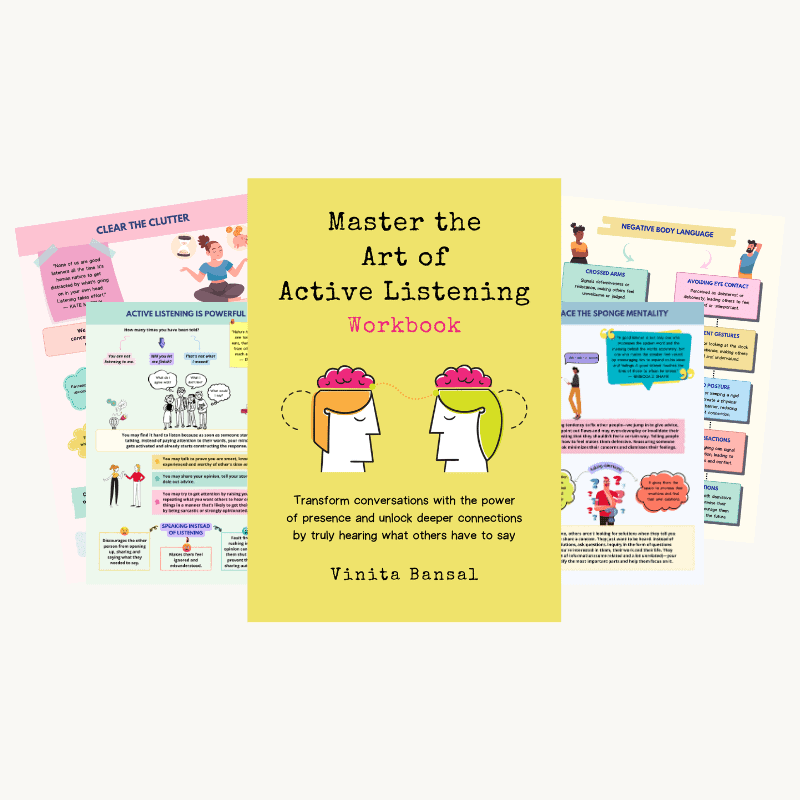
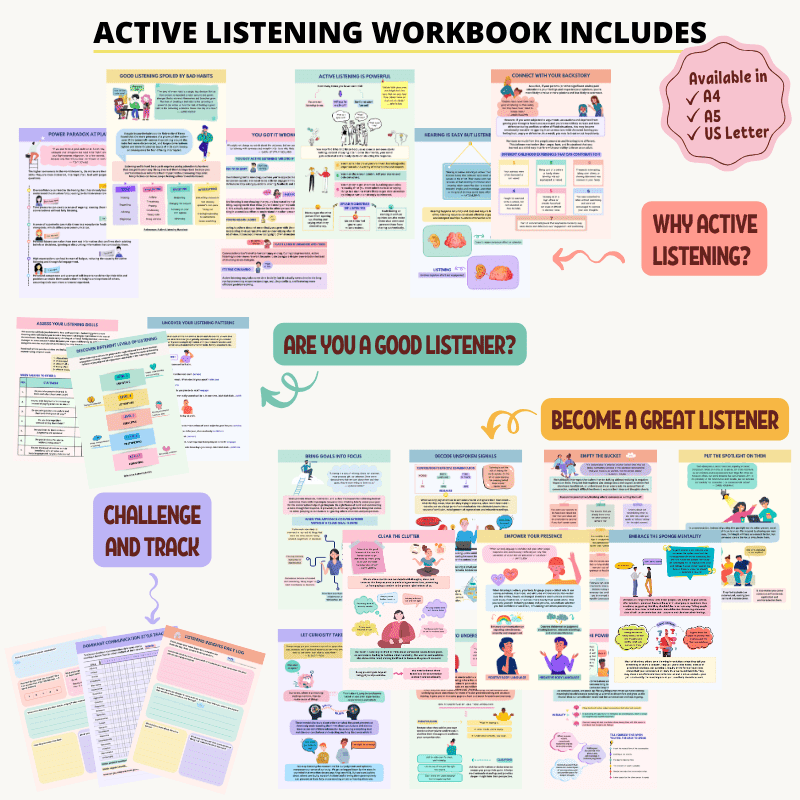

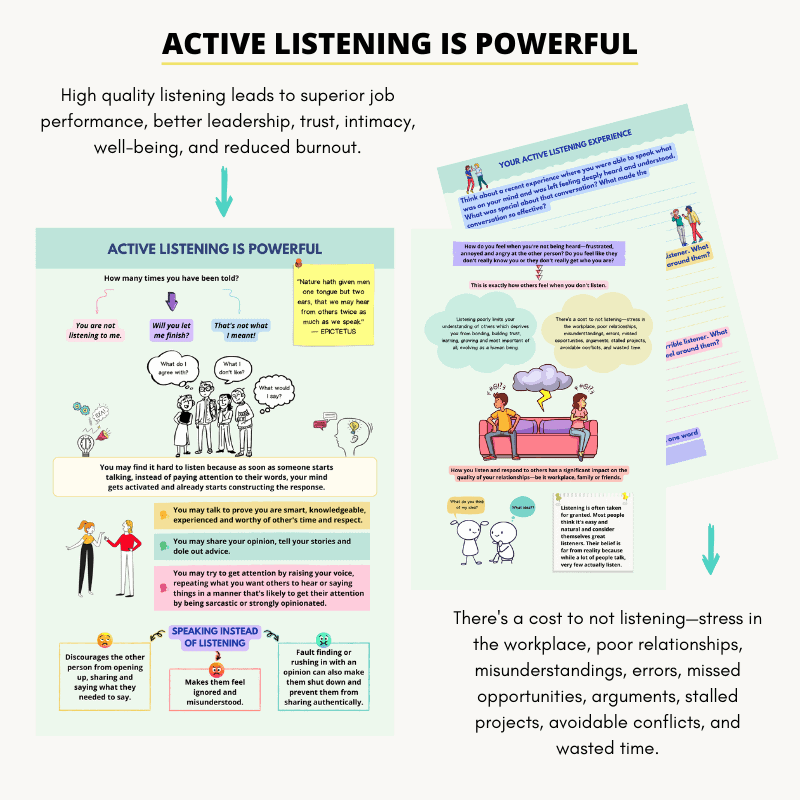
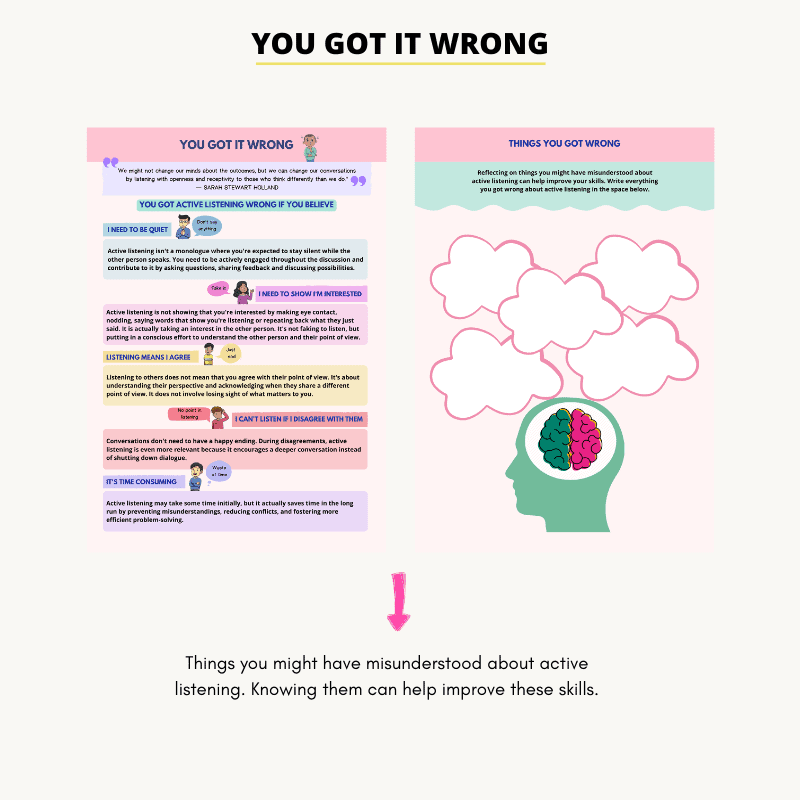
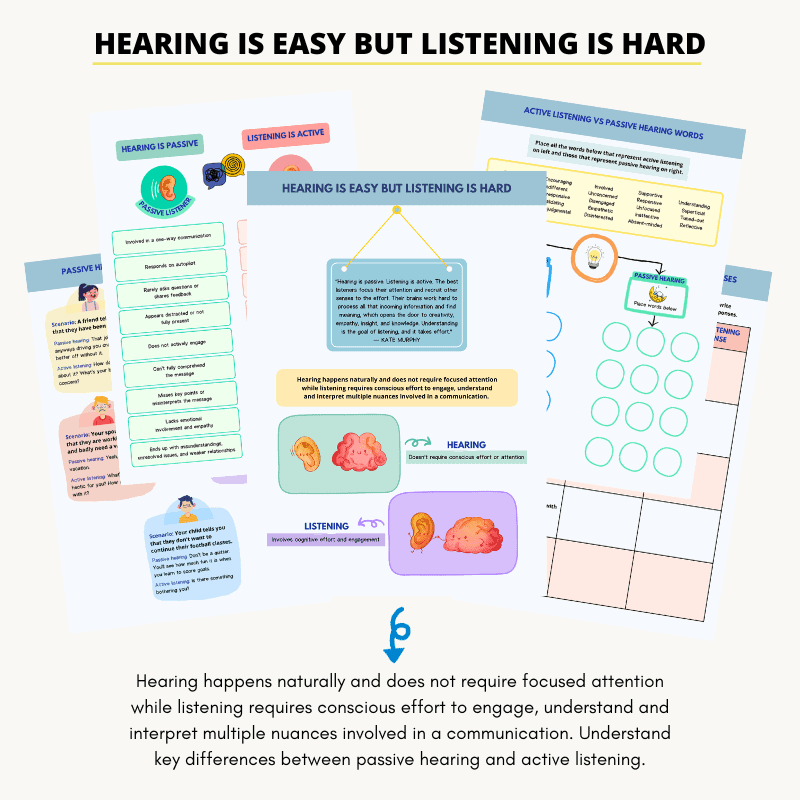
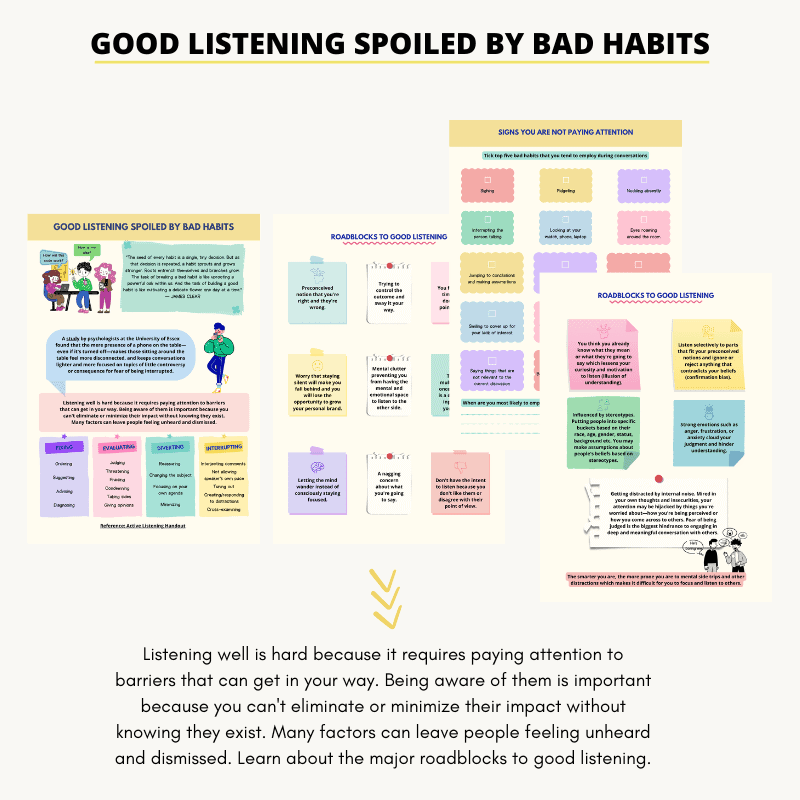
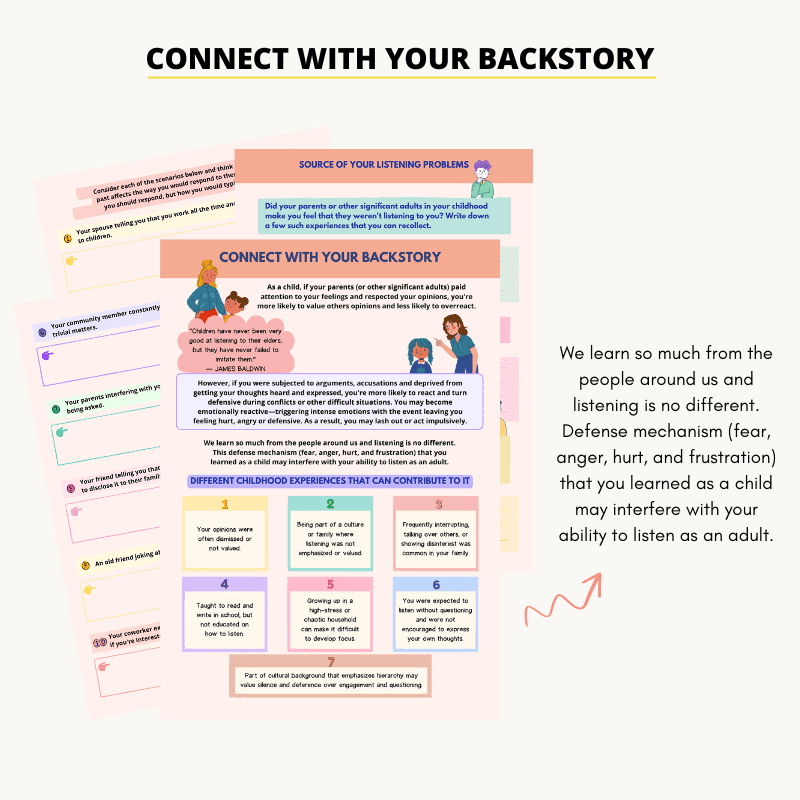

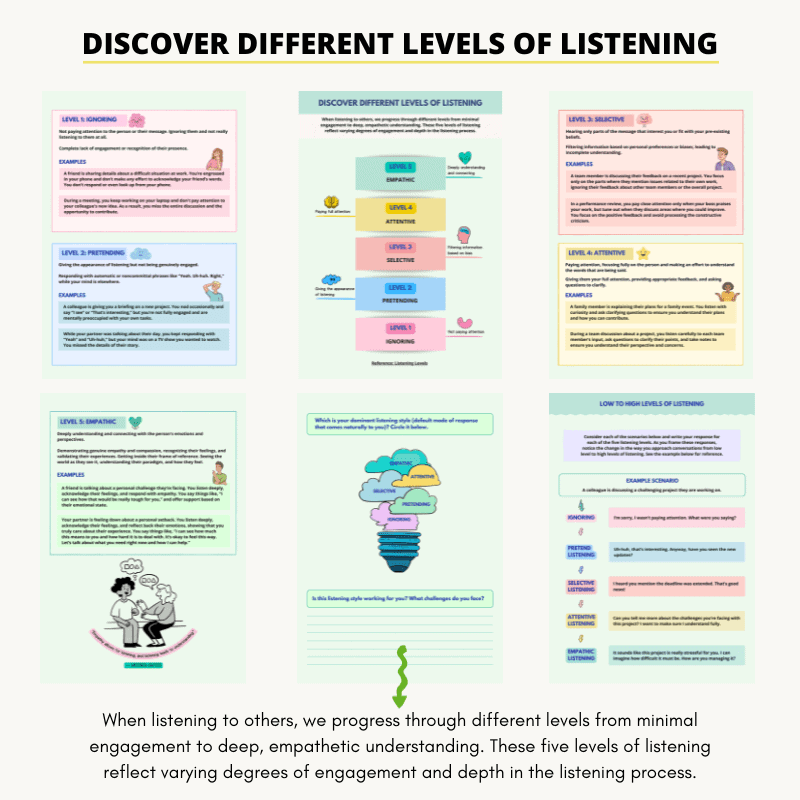
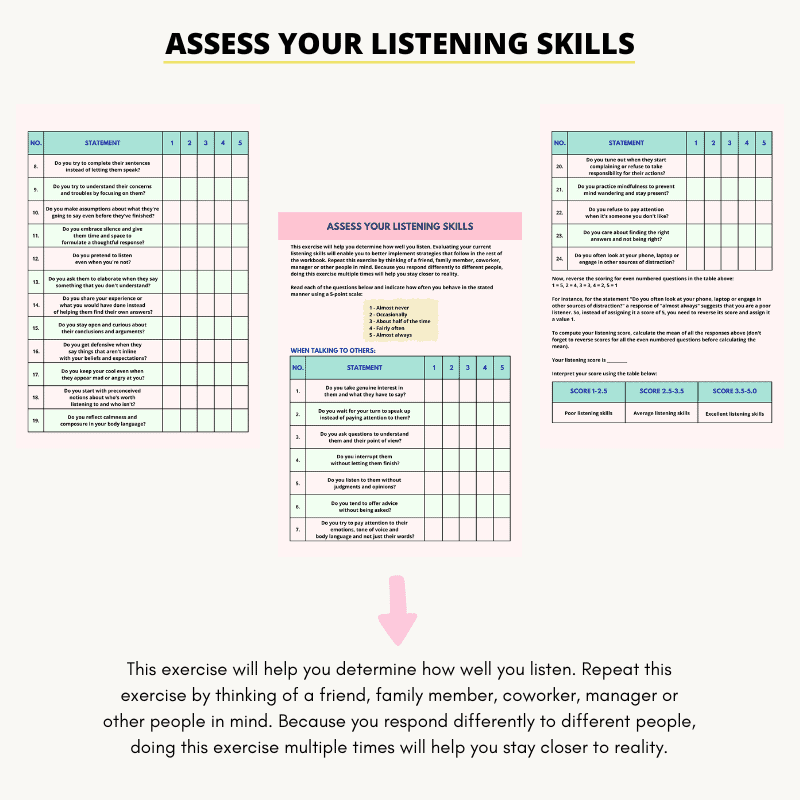
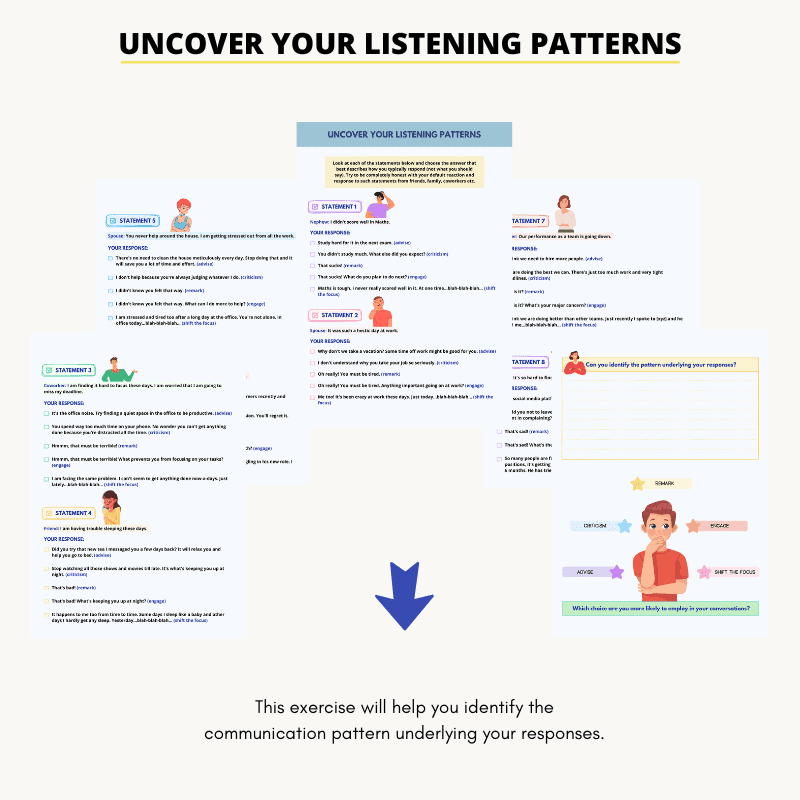

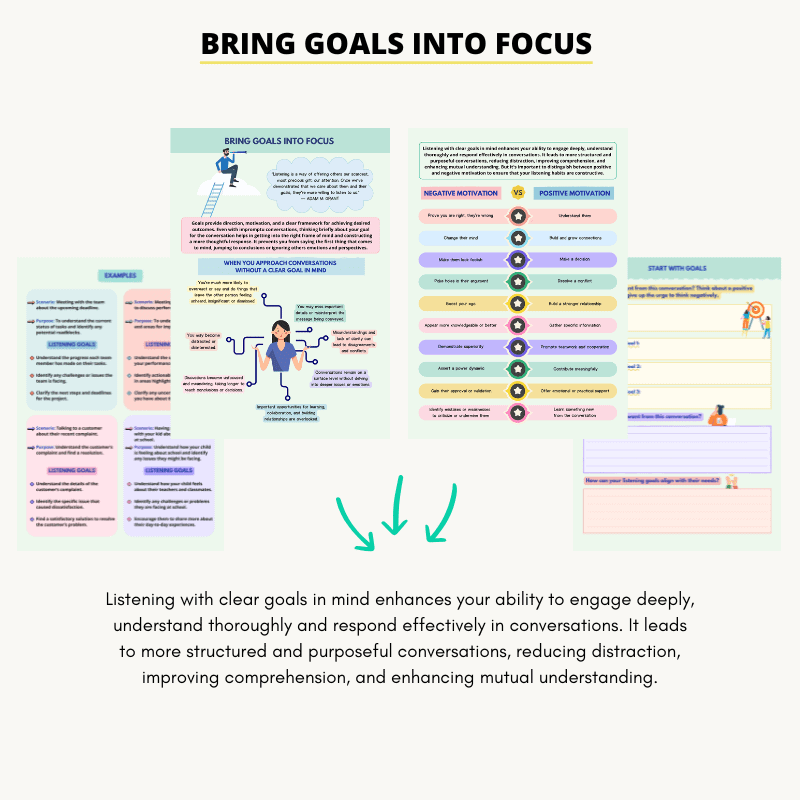
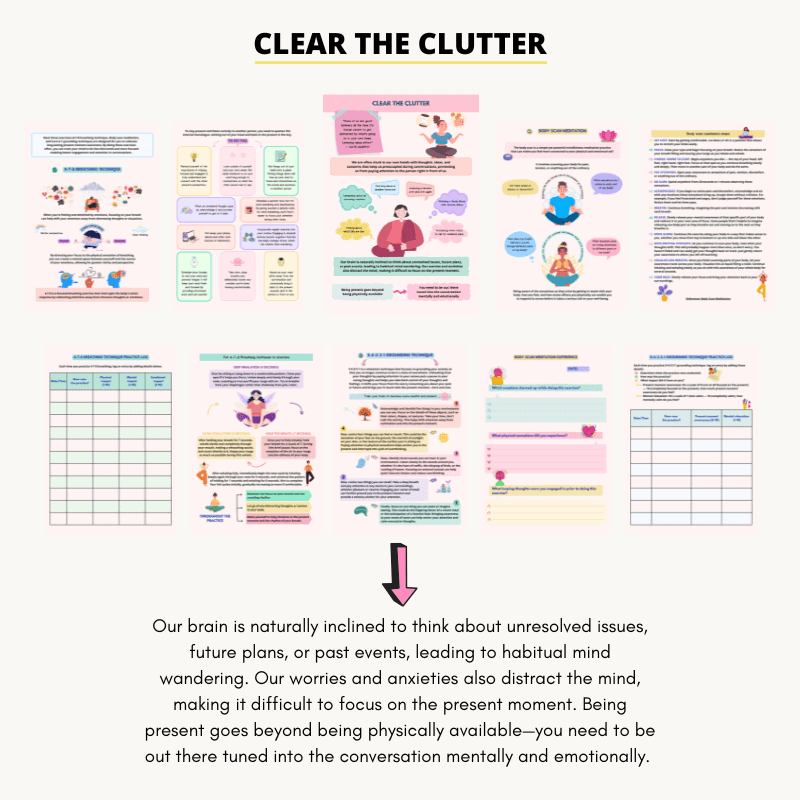
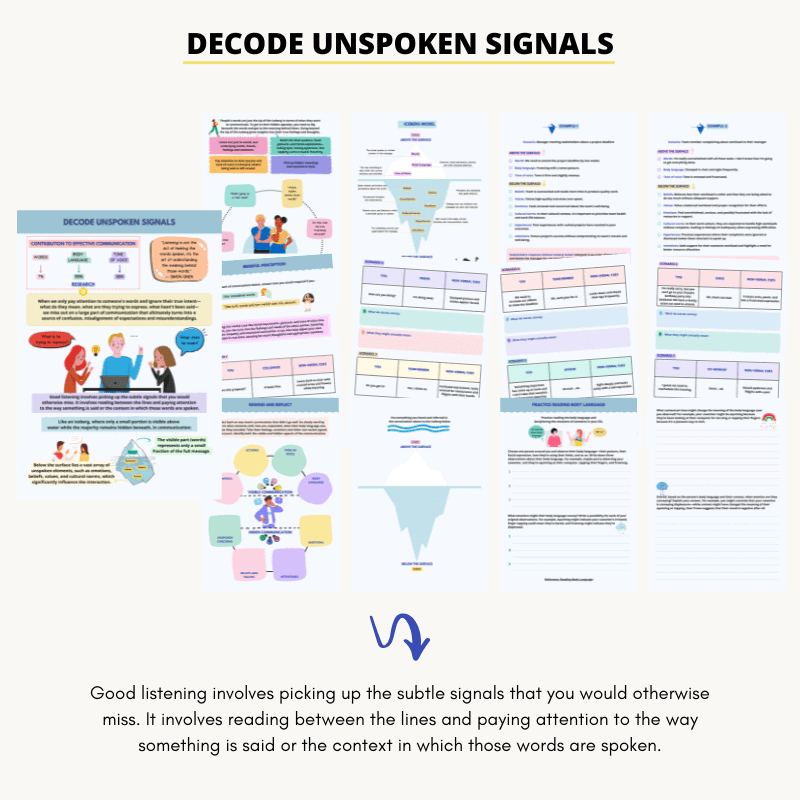
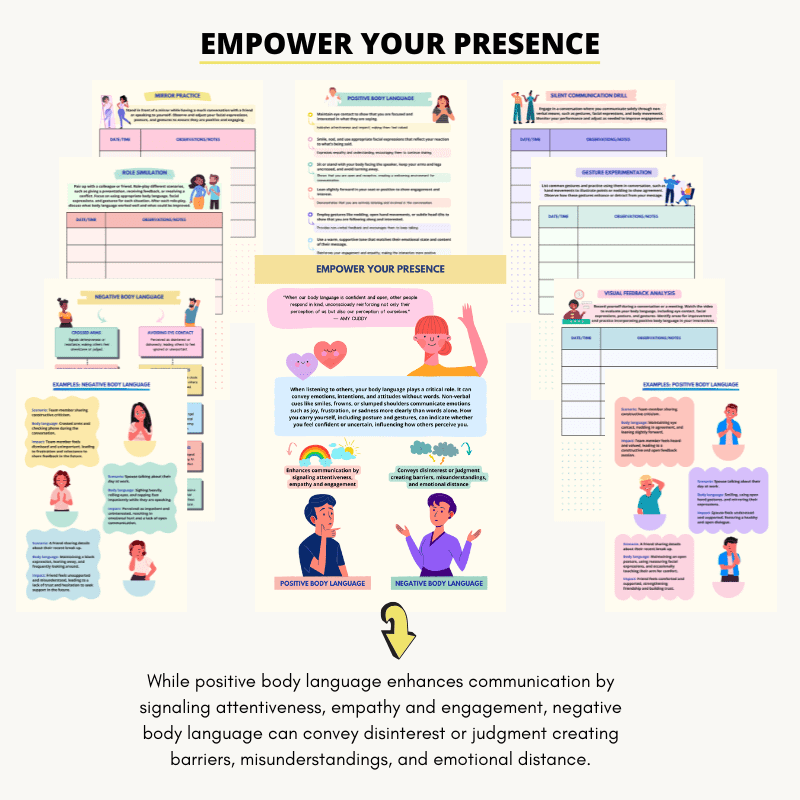

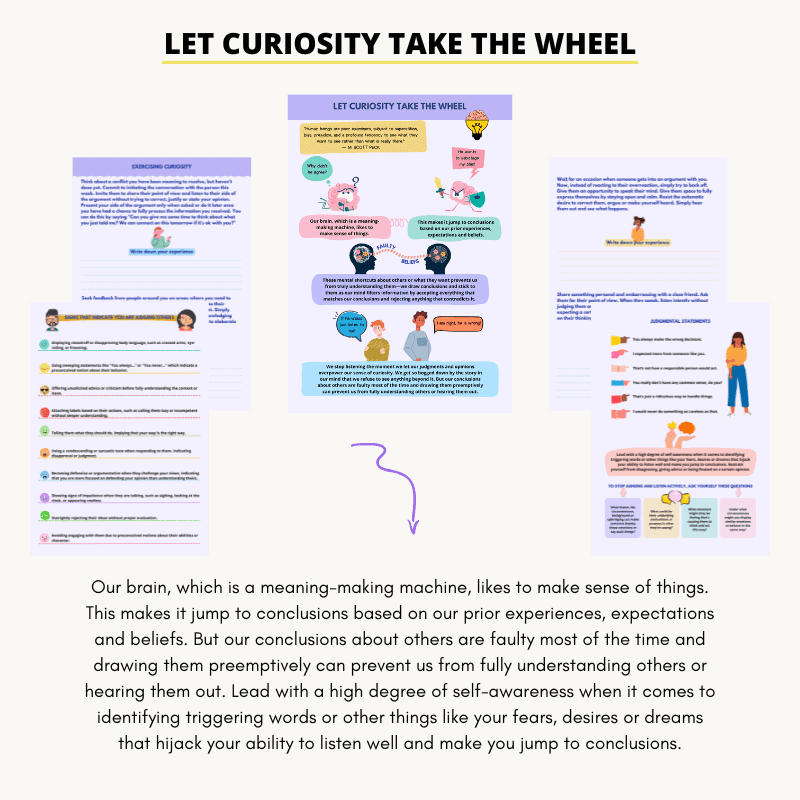

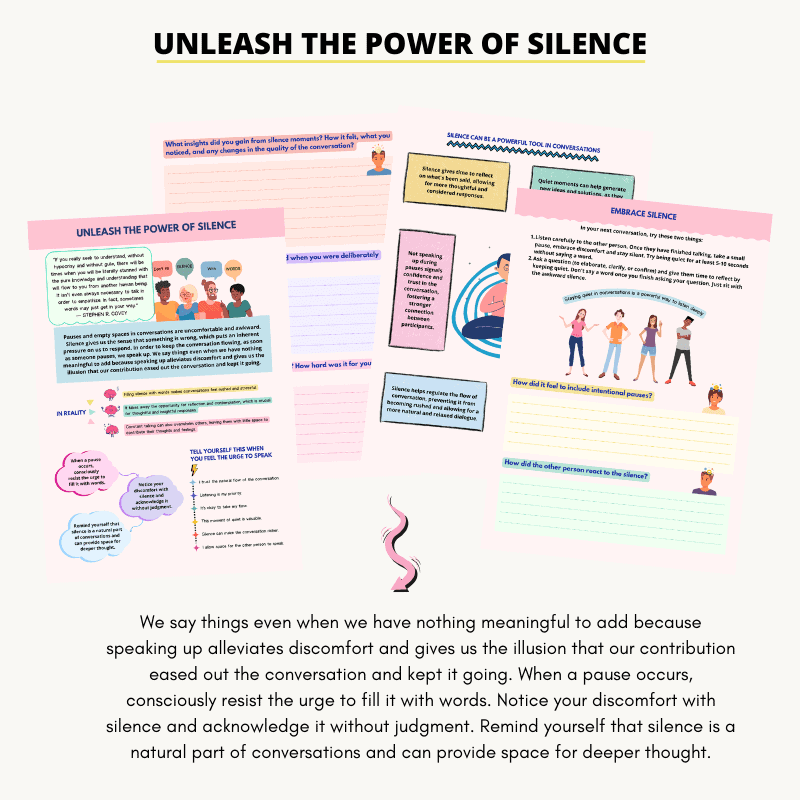
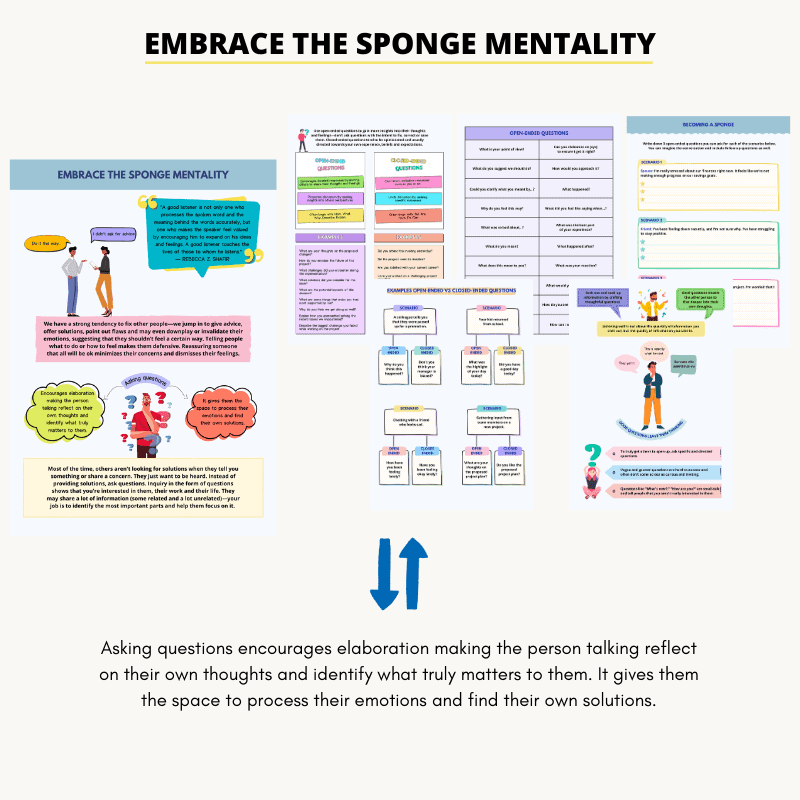
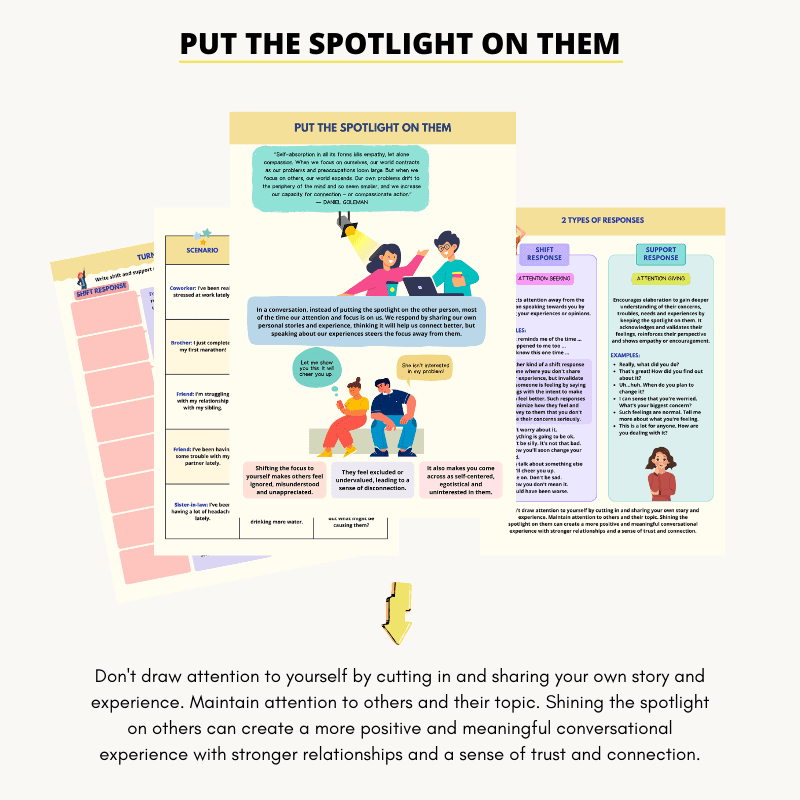
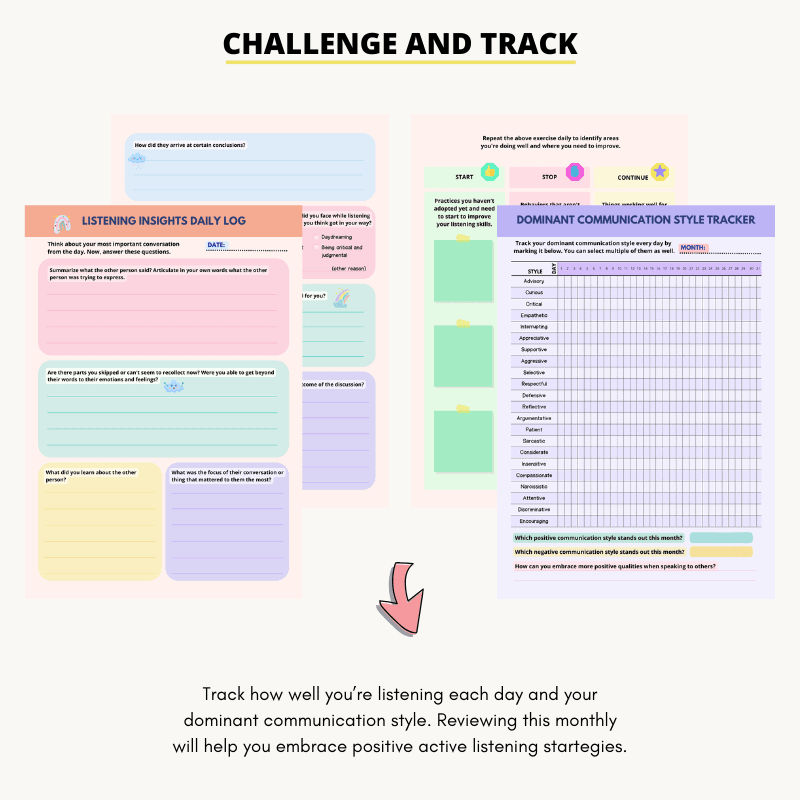
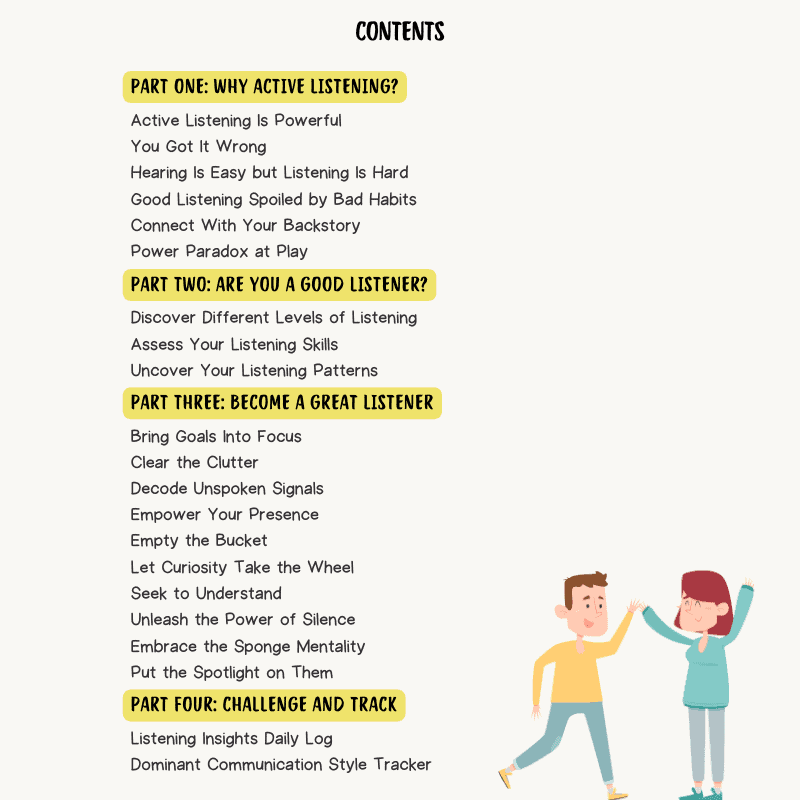
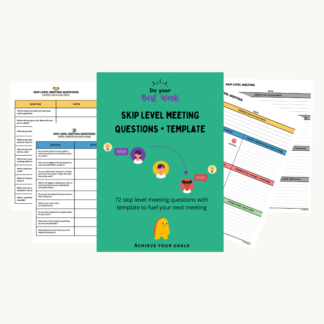
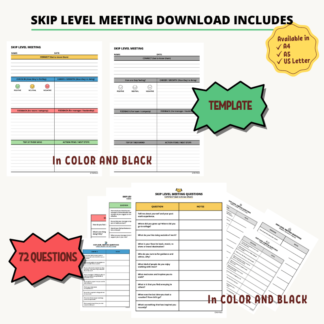
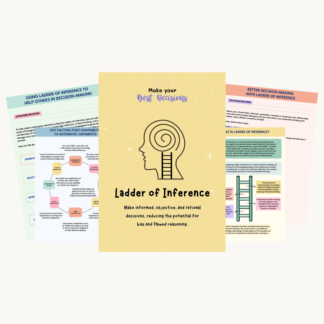
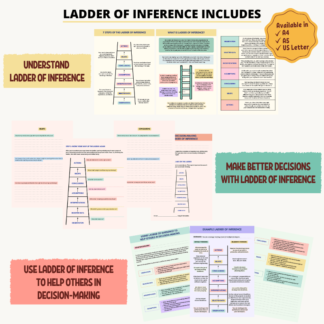
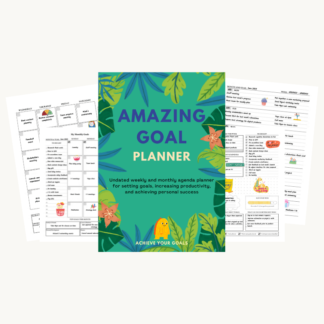
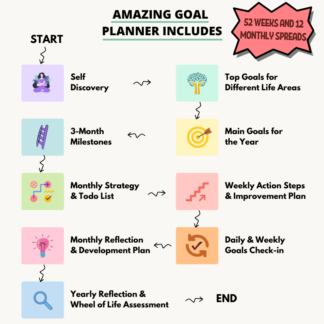
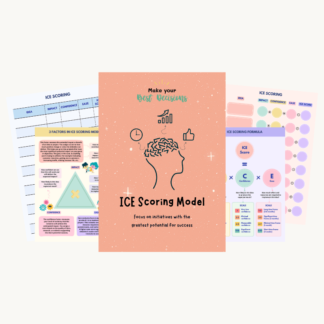
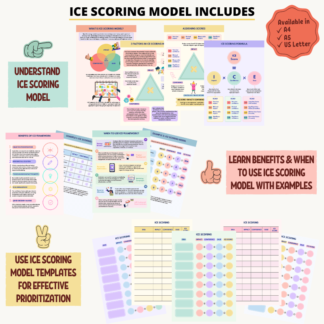
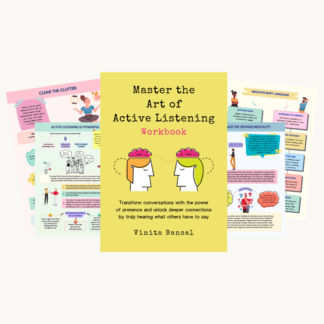
Reviews
There are no reviews yet.